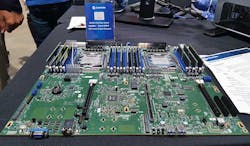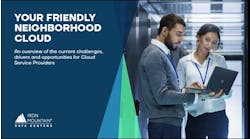Last January we identified eight themes that we believed would shape the data center business in 2018. How did we do? Let’s take a look and see how we did, ranking whether each prediction was a Hit, Miss or Too Early.
1. On-Premise Workloads Migrate into Cloud and Colo
DCF prediction: Enterprises are getting religion about moving workloads off-premises. The trend will continue in 2018, creating sustained business for IT infrastructure providers. The cloud and colocation industries have reached a level of maturity that offers compelling value, breaking down the historic resistance to moving data offsite.
HIT: By any measure, 2018 was a year in which cloud computing experienced phenomenal growth, driven by a combination of new technology and deployments that previously would have lived in enterprise data centers. This was seen in the revenue growth reported by major cloud platforms, the super-sizing of wholesale leasing deals, the boom in data center construction, and the renewed buzziness around hybrid cloud.
2. Latency Reshapes Cloud Infrastructure
DCF prediction: Most major cloud campuses have been closer to cows than cities, driving data center building booms in rural areas of Oregon, Iowa and North Carolina. That’s starting to change, as rapid growth and new workload profiles require that data be housed closer to end users.
HIT: This trend was easily visible in deal growth, provider expansions, and cloud platforms’ real estate acquisitions (land banking), as we outline in our August story, “Cloud Data Centers Are Moving to the Suburbs.” Industry watchers noted that the trend “is prompting historic data center building booms in markets like Dallas, Phoenix and Atlanta. In recent months, a flurry of hyperscale announcements indicate that new developers bringing projects to those markets may be rewarded. … That is a factor in recent land purchases by Microsoft in Silicon Valley and Google in Northern Virginia, markets where they have previously leased space. The message: The larger scale needed to provide low-latency services to these markets has altered the economics, making it more cost-effective for these tech titans to build rather than buy their data center capacity.”
3. Wireless, Data Center Industries Meet at the Edge
DCF prediction: The growing overlap between the data center and wireless worlds … will gain momentum in 2018 and beyond. The impending arrival of 5G wireless networks will be an enabler of new technologies that shift IT infrastructure outside of core markets, and require additional integration between data centers, telecom towers and antennas. Analytics for new technologies will require processing and storage, sorting oceans of sensor data into smaller datasets to send across the network.
TOO EARLY: But intentionally so, as we noted in characterizing the timeframe as “2018 and beyond.” The trend is clearly visible in investments from tower operators like Crown Castle and Digital Bridge, but their engagement really began in 2017. Same goes for EdgeConneX, which was an early crossover from towers and small cells into the data center world.
One factor in the timeline is the gradual emergence of standards and technology for 5G wireless, which is crucial to the ambitions of edge-focused data center startups like Vapor IO, EdgeMicro and DartPoints. These companies all say they are working on trials with major mobile networks, who will be crucial to their business success. We should have a better sense of the pace of this transition and how this is progressing in the first half of 2019.
4. AI Hardware Everywhere, From the Data Center to the Device
DCF prediction: Artificial intelligence was a big trend in 2017, as just about everyone sought to leverage machine learning to enhance their products and services. In 2018, we’ll see the AI boom continue to drive new hardware offerings, both in hyperscale data centers and in the devices in our pockets.
HIT: There are more options for processing and compute power than we’ve seen in many years, and perhaps ever. In 2018 we saw new startups, more powerful GPUs, and continued innovation at scale with FPGAs. Google’s customers TPUs became so powerful that it shifted to liquid cooling for its AI infrastructure. Expect this trend to continue in 2019.
5. Opportunities Emerge in Next-Generation Tech
DCF prediction: Cloud and enterprise are driving the headlines. But next-generation technologies like the Internet of Things, blockchain and bitcoin, genomics, robotics, drones and autonomous cars are taking shape, and data center operators are closely tracking the opportunities in these sectors, which typically emerge in clusters around geographic development hubs.
TOO EARLY: Most of the real-world action from new tech has been in AI, with pockets of growth and impact for these other next-generation technologies. There’s clearly a growing volume of activity in the Industrial Internet of Things, and smart speakers like the Amazon Echo saw rapid adoption that signals short-term growth from voice-enabled applications. But it was a rough year for bitcoin and cryptocurrency, and predictions of near-term deployments of autonomous vehicles at scale have turned out to be optimistic.
But there’s growth coming for consumer IoT (as seen in Bill Kleyman’s piece on “The Cloud-Powered Parent: Raising Baby, One App At A Time”) and there are signs that the horizon for meaningful use of augmented reality is moving closer.
6. Consolidation Continues. Will Deals Remain Disciplined?
DCF prediction: A growing pool of global investors seeking to put money to work in the data center and cloud sector, providing ample liquidity. One concern is that new players may move to capture market share through aggressive pricing or speculative data center development. … In addition, the competitiveness of recent M&A deals could prompt more aggressive bidding in 2018, which in turn could boost valuations.
We posed this as a question rather than a statement, but we believe the underlying premise – aggressive bidding and valuations – qualifies as a HIT and that the data center industry did pretty well on the “remaining disciplined” part. Case in point on pricing: The $800 million price tag paid by Equinix for the Dallas Infomart, which works out to about 40 times the annual revenue for the building. The Infomart was a special situation, particularly for Equinix, which operates four data centers there and needs room to grow. However, the strong recent valuations resulted in more selective deals in 2018, compared to the blockbuster M&A activity in 2017, even as investor interest in the sector remained extremely high. This appears to hold true both for corporate M&A and data center sale-leasebacks. Folks are shopping, but being careful to stick to their objectives on value and strategy.
On the supply question, the markets with the highest volumes of data center construction also had the highest levels of pre-leasing, as most players were careful about large speculative builds. As a result, pricing remained steady in most markets. The fourth quarter earnings calls featured interesting discussions about whether competition in Northern Virginia was translating into lower pricing – executives at CoreSite said yes, but their counterparts at Digital Realty, CyrusOne and QTS said pricing remained steady.
7. Hyperscalers Lead The Transition To Renewable Energy
DCF prediction: Cloud computing has emerged as a surprising force for the commercialization of renewable energy at Internet scale. We expect to see this trend accelerate in 2018, as Google, Amazon, Microsoft and Apple are all committed to sourcing renewable energy to power their cloud data centers.
HIT: In 2018 Facebook announced power purchase agreements for 1,850 megawatts of renewable energy in 2018, helping corporate buyers set a new single-year record for green power procurement, according to the Rocky Mountain Institute. Google, Microsoft and Amazon Web Services all announced PPAs for green power. Multi-tenant service providers like Digital Realty also used their scale to construct multi-campus deals that improved their pricing on power, and position them to join the hyperscalers in constructing creative ways to acquire renewable energy at scale.
Will this continue in 2019? Recent media coverage has raised questions about Amazon’s commitment to the economics of green power, so the industry will be watching how it follows through on its environmental goals, as will groups like Greenpeace. But the other major hyperscalers appear fully committed to building a renewably-powered cloud, and helping their investments seed further progress on climate change.
8. NIMBY Issues Become More Pronounced
DCF prediction: The pace of data center development has prompted a growing number of local disputes, as residents seek to block or revise plans to build new facilities in their town. These NIMBY (Not in My BackYard) disputes have emerged over the years, but saw an upswing in the second half of 2017. Expect to see more headlines about data center controversies in 2018.
MISS: We totally expected to see more NIMBY controversies in 2018, but this gladly turned out to be a total whiff. There were no major new development controversies with data centers and their neighbors, and the long-running dispute over power lines for an AWS data center in Haymarket, Virginia was finally resolved. A good sign for 2019? Let’s hope.
FINAL SCORE: Five hits, one miss and two predictions that qualify as “Too Early.”
Want to know what’s coming in 2019? Look for our 2019 trends in the coming days. You can be sure you don’t miss them by following me on Twitter andthe DCF Facebook page, connecting with me on LinkedIn, and signing up for our weekly newspaper using the form below:






